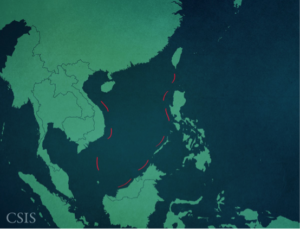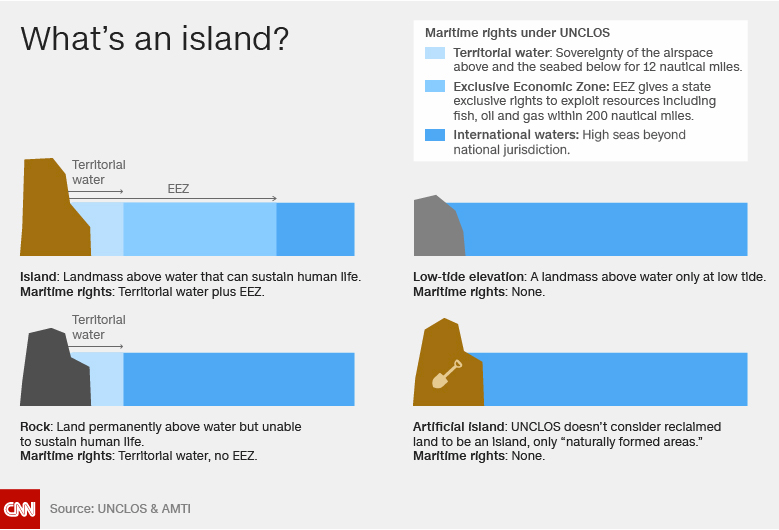This is Part I of a two-part blog post on territorial disputes in the South China Sea. Part I explains the legal effects of the July 2016 arbitration award rendered by the Permanent Court of Arbitration at The Hague, and Part II will discuss the practical effects the decision will have on shipping, oil and gas exploration, and commercial fishing in the South China Sea.
On July 12, 2016 the Permanent Court of Arbitration at The Hague (the Tribunal) issued an award in a dispute between China and the Philippines over their conflicting claims to areas within the South China Sea.1 In its award, the Tribunal made two findings in particular that have the ability to significantly alter the situation in the South China Sea. First, the Tribunal rejected China’s claim to the area within the “Nine-dash-line”, a claim made historically by China encompassing nearly the whole of the South China Sea.2 Second, the Tribunal found that the features in dispute in the case were not islands, but rather “rocks” and “low-elevations”, definitions which carry significance under the Convention on the Law of the Sea (UNCLOS).3 These findings deeply undermine China’s projection of power over the South China Sea and carry a number of potential economic consequences within the region and globally, specifically with regard to energy, shipping, and commercial fishing. In this first of two blog posts on the issue, I will explore the significance of the Tribunal’s two major findings.
The Nine-Dash Line

The “nine-dash line” is used to express China’s claims over the whole of the South China Sea, dating officially back to a declaration made in 1958.5 In other, more recent communications on the topic, China has maintained that its position on the nine-dash line is “consistently held . . . and widely known by the international community.”6 While China has consistently maintained these claims, the legal validity of their historical basis—dating back to general comments made regarding the area during the Ming Dynasty7 —has been questioned.8
In rejecting these claims, the Tribunal limited China’s maritime jurisdiction to what is explicitly agreed upon in the UNCLOS.9 Interestingly, this view aligns with one previously expressed by China in the Third Conference on the Law of the Sea, in which the Chinese delegate suggested that coastal states should have exclusive rights over the resources within the specific zone of economic control, regardless of historical claims or exploitation by other nations.10 This logic mirrors that of the Tribunal in its finding that the UNCLOS formed an agreement that superseded any other claims of its signatories which conflict with its terms.11
Rocks, Islands, and Elevations

The second major finding of the Tribunal’s award was that none of the disputed formations constituted islands under the UNCLOS. This finding greatly affects the maritime rights granted to a nation that has sovereignty over a specific feature. Although the Tribunal did not make any decisions regarding territorial sovereignty over the features,13 but this finding makes the point mostly moot because by finding that none of the features were islands in the meaning of the UNCLOS, the Tribunal established territorial sea as the maximum maritime right enjoyed by whichever state has sovereignty over a feature.14
The Tribunal’s finding drastically limits the control that China, or any nation, could assert over resources around the disputed features. Had the Tribunal found that these features were islands, they would be entitled to exclusive economic zone, extending up to 200 nautical miles from the island’s shores in which the controlling nation would have exclusive rights to natural resources (mainly fish and oil).15 However, the maximum right afforded states for the disputed features is territorial sea, which includes more significant sovereignty, but extends to a distance of only 12 nautical miles from the shoreline.16 Given the abundance of fisheries in the South China Sea and the possibility of vast oil deposits, as will be discussed in Part II of this blog, the limitation of exclusivity to 12 nautical miles has the potential to open crucial fishing grounds and oil deposits to regional powers desperately in need of both food and energy.
In re South China Sea Arb. (Philippines v. China), No. 2013-19 at 472 (Perm. Ct. of Arb. 2016), https://pca-cpa.org/wp-content/uploads/sites/175/2016/07/PH-CN-20160712-Award.pdf [hereinafter South China Sea Arbitration]. ↩
Id. at para. 1203(B)(2). ↩
Id. at para. 1203(B)(7). ↩
18 Maps That Explain Maritime Security in Asia, Asia Maritime Transparency Initiative, https://amti.csis.org/atlas/. ↩
Declaration of the Government of the People’s Republic of China on China’s Territorial Sea, para. 1 (1958), http://www.asianlii.org/cn/legis/cen/laws/rotscotnpcotaotdotgocts1338/. ↩
Note Verbale CML/17/2009 from the Permanent Mission of the People’s Republic of China to the UN Secretary-General (May 7, 2009), http://www.un.org/Depts/los/clcs_new/submissions_files/submission_mysvnm_33_2009.htm; Note Verbale CML/18/2009 from the Permanent Mission of the People’s Republic of China to the UN Secretary-General (May 7, 2009), http://www.un.org/Depts/los/clcs_new/submissions_files/submission_vnm_37_2009.htm. ↩
Su Hao, China’s Positions and Interests in the South China Sea: A Rational Choices in its Cooperative Policies 1 (2011), http://csis.org/publication/chinas-positions-and-interests-south-china-sea-rational-choices-itscooperative-policies. ↩
See Florian Dupuy & Pierre-Marie Dupuy, A Legal Analysis of China’s Historic Rights Claim in the South China Sea, 107 Am. J. Int’l. L. 124 (2013). ↩
South China Sea Arbitration, supra note 1, para. 1203 (B)(1). ↩
Summary Records of Meetings of the Second Committee, 24th mtg. at para. 2, UN Doc. A/CONF.62/C.2/SR.24 (Aug. 1, 1974). ↩
South China Sea Arbitration, supra note 1, at para. 1203 (B)(2). ↩
Katie Hunt, South China Sea: Court Rules in Favor of Philippines over China, CNN (July 12, 2016), http://www.cnn.com/2016/07/12/asia/china-philippines-south-china-sea. ↩
South China Sea Arbitration, supra note 1, para. 157. ↩
Id. at para. 1203(B)(7). ↩
United Nations Convention on the Law of the Sea, art. 55, Dec. 10 1982, 1833 U.N.T.S. 397. ↩
Id. at art. 2. ↩
